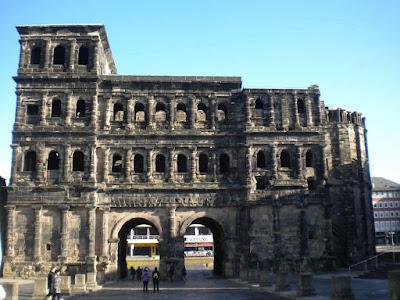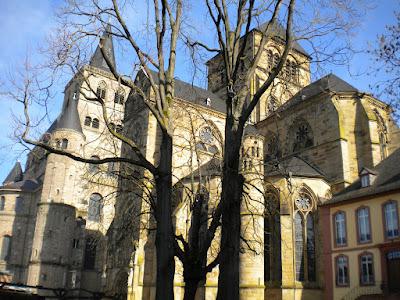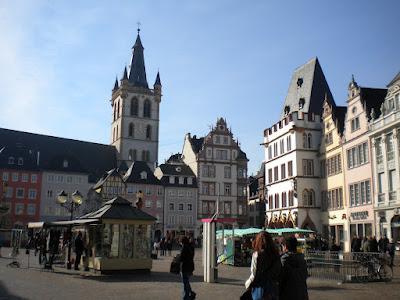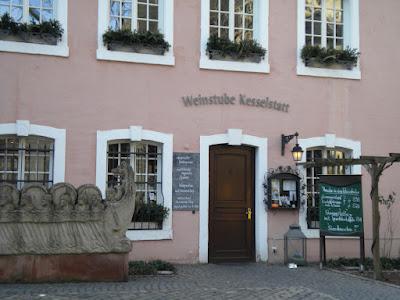
Porta Nigra
The bishopric of Trier is also the oldest in Germany. In the middle ages the Bishop of Trier was one of seven electors in Holy Roman Empire. This period of Trier's history is visible in the Dom (Cathedral), begun by Constantine in the fourth century. It's been renovated continuously over the next 1500 years, but retains its Romanesque design.

Trier's Dom, the Cathedral
The Liebfrauenkirche, a Gothic construction from the 13th century, is adjacent to the Dom, connected by a tunnel. My friend Gabi was baptized here (for the first time; when her father remarried she had to be re-baptized in a Protestant church).

The Liebfrauenkirche, Trier's parish church
Just past the Liebrauenkirche comes the Bishop's Palace and its gardens. Gabi and her friends used to hang out in the gardens smoking cigarettes. On Ash Wednesday they marked each other's forheads with cigarette ashes so their parents would think they'd been to church services.

The Bishop"s palace, the Rococo home of Trier's Archbishops until 1794
In a corner of the Bishop's Gardens you'll find the Rheinland Museum, whose focus is Trier's Roman period. There's an impressive collection of statues and tombs, and a "sound and light show" in which the reliefs on the tombs come to life with voices and colored light. The most interesting part of that for me was the realization that these elegant Roman carvings I think of as stately monochromatic marble or stone were originally painted in a variety of bright colors, creating a very different impression.
On the other side of town, next to the Porta Nigra, is the Simeonstift Stadtmuseum, which begins with Trier's medieval history and continues to the present. There was an installation with dozens of videos of interviews with Trier's holocaust survivors. I watched an elderly woman in a Manhattan apartment in 1996 tell her story, and it was fascinating to hear how she hadn't experienced any antisemitism before the Nazis came to power. She'd had many Catholic friends as a child, and was as welcome in their homes as they were in hers. Then suddenly she wasn't allowed in certain classes in school (such as Biology, where the others were taught about the genetic inferiority of Jews). She'd been an aspiring pianist, but her piano was destroyed in Kristallnacht, along with anything else belonging to Jews. She was able to escape by securing a position as an au pair in England.
The third museum I visited in Trier was the Karl Marx Haus, in which Karl Marx was born. There's not really much there, so I wouldn't put it on a must-see list unless you really need the 20th century history review you get by reading the placards describing Marx's life and work.

The Hauptmarkt, with St. Gandolf's Church
Aside from all the sight-seeing there is to do in Trier its also nice to just wander around the old center around the Hauptmarkt which is a charming pedestrian shopping zone. I wondered about all the upscale designer shops in what Gabi had described as a working-class town, but she explained that the wealthy Luxembourgers come across the nearby border to take advantage of the lower prices and greater variety.
I hadn't intended to buy anything, but I saw some fun coats hanging outside a shop. I recognized them as the Italian designer, though they are copies, which made them affordable. Ther are also leather shops, and I needed a wallet (the ones I buy at the Turkish bazaar disintegrate within a month or so). So, purchase # 2.
Trier also has specialty tea shops. I do enjoy Turkish tea in Antalya, but I also like a little variety in my daily cup, so I picked up some Assam and Keemun. Purchase #3. There are several enticing candy shops downtown, mostly focussing on chocolate. But I ended up shopping at the chain store, Husserl, because they had those salty licorice drops I became addicted to when I was singing in Amsterdam. I'm not counting them as a purchase because I knew they'd be eaten during my time in Germany and thus wouldn't threaten the weight limit of my suitcase.

Weinstube Kesselstatt, where I stopped for lunch
After all this sightseeing and shopping, it was time to stop for a meal. Right across from the Dom I spotted a little weinstube, which had just the right casual but warm (gemütlich) atmosphere for a relaxing break. I didn't have any wine, despite being tempted by the sight of all the casks, because it makes me sleepy. But I had a very filling meal of Linsentopfe (lentil soup) and wurst (there's no getting away from the wurst, it seems). Lentil soup is ubiquitous in Turkey, but it's very different here. Turkish lentil soup is usually made with red or yellow lentils cooked to a thin puree and spiced with cumin. German lentil soup is made with whole black lentils, resulting in something more like a lentil stew. The Turkish soup is a first course; the German version is a meal in itself.
After lunch it was time to head back to Euren to meet Gabi at the ice cream shop for a capuccino. Later we'd go out for a schnitzel. If it sounds like my trip to Germany revolved around food, well, it was a big part of it. Not that there's anything wrong with Turkish food, but I was enjoying the different offerings of German cuisine, as well as the availability of brewed coffee and the absence of the dreaded Nescafe.

